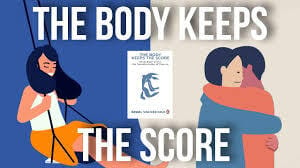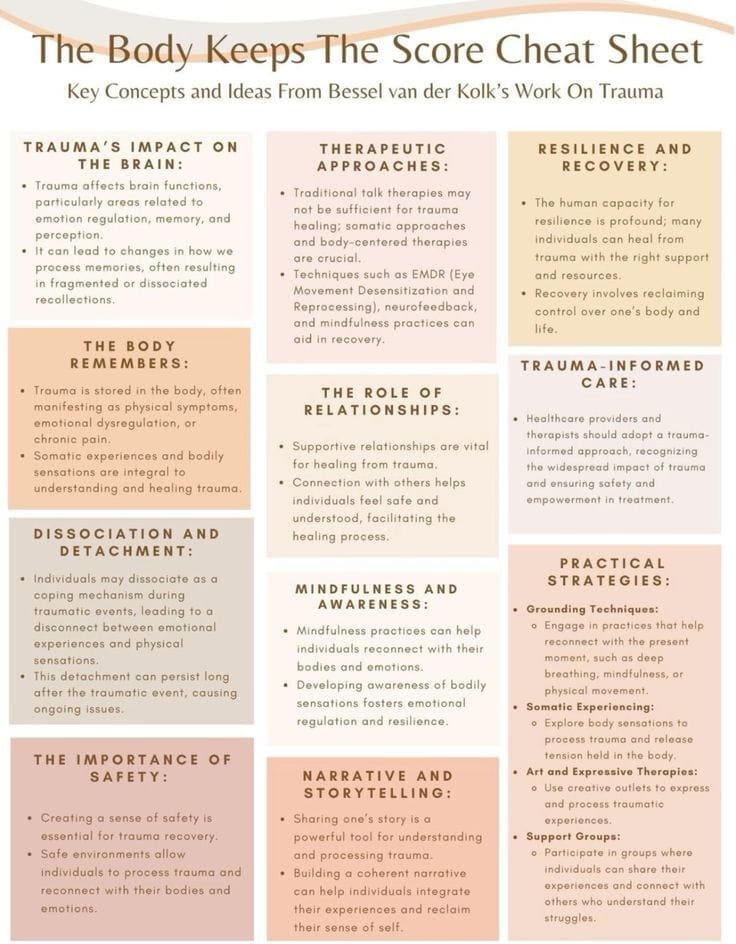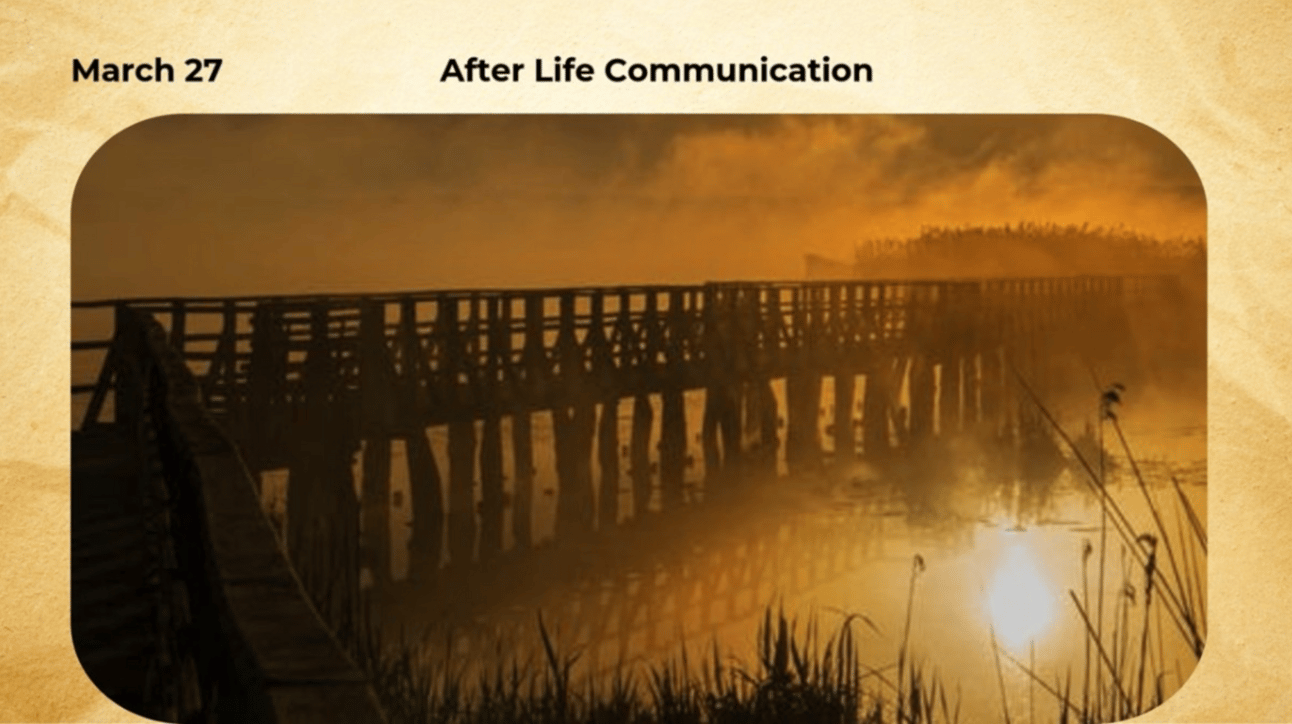- Tucson Spiritual Living
- Posts
- Healing Trauma Without Therapy?
Healing Trauma Without Therapy?
The Unexpected Lessons from a Month of Trauma Exercises
Hello, and Happy Saturday!
In today’s newsletter, we’ll do a deep dive into an amazing healing practice developed by Dr. Bessel van der Kolk who wrote the book, The Body Keeps the Score.
I read an interview with someone who thoroughly tested Dr. van der Kolk’s method and the healing results were truly astounding (I summarized the person’s experience below). I’m in the process of going through the steps myself and will keep you updated on my progress as well!
I’ll also share with you a local Tucson event coming up on March 27th called After Life Communication. I like to keep an open mind about the possibility of communication with our departed loved ones and will personally be attending. Maybe I’ll see you there :)
Enjoy!
A 30-Day Journey Through The Body Keeps the Score—What Changed?

Can Trauma Healing Exercises Really Make a Difference?
For years, one individual struggled with unexplained anxiety and a deep sense of disconnection from their body. Seeking answers, they turned to Dr. Bessel van der Kolk’s The Body Keeps the Score, a groundbreaking book on trauma and body-based healing.
What started as casual reading quickly evolved into a 30-day commitment to daily exercises designed to heal trauma from the inside out. The results were subtle yet profound.
Week 1: Confronting Resistance and Restlessness
The journey began with basic breathing and body scan exercises. At first, even five minutes of stillness felt unbearable. Their mind raced, their body twitched, and they found themselves constantly checking the clock.
As van der Kolk explains, this kind of resistance is common in those who have lived in a heightened state of vigilance for years. The body struggles to slow down when it has been conditioned to stay on high alert.
By the end of the first week, however, something shifted. They could sit still for ten minutes without distraction—a small but meaningful step forward.
Week 2: Unlocking Suppressed Emotions
In week two, they attempted a yoga nidra exercise from Chapter 13. Midway through, unexpected tears welled up—not from sadness, but from a deep release. It was the first time they had cried in years.
Van der Kolk’s work explains how trauma survivors often disconnect from their emotions, fearing that feeling too much could be overwhelming. Yet instead of feeling drained, they reported a sense of lightness afterward.
Week 3: Releasing Trauma Through Movement
One of the book’s key teachings is that trauma gets “stuck” in the body, and movement is a powerful tool for release. In week three, they incorporated rhythmic exercises from Chapter 16.
At first, dancing alone felt awkward. But by day 18, they reached what van der Kolk describes as a “flow state”—a moment of pure, unselfconscious movement. Their shoulders, once perpetually tense, finally relaxed. That night, they slept soundly without waking up—something that had eluded them for years.
The final week brought the most challenging exercises—those involving social engagement. One simple practice involved maintaining eye contact while regulating the breath, as described in Chapter 20.
This seemingly small change had a significant impact. They realized how often they looked away in conversations, avoiding vulnerability. Over time, their confidence grew. Others noticed the change first—especially in their voice. They began speaking up in meetings, no longer hesitating out of fear.
The Lasting Effects of 30 Days
Rather than a sudden breakthrough, the changes were gradual but powerful:
Physical symptoms like stomach knots, jaw clenching, and heart palpitations faded
They became more aware of emotional states before they became overwhelming
Sleep improved dramatically, with fewer nightmares and fewer middle-of-the-night panic episodes
They no longer dissociated during stressful conversations
Instead of blaming themselves for being “too sensitive,” they developed a deeper understanding of their triggers
The Key Takeaway: Healing Starts with the Body
Van der Kolk emphasizes that trauma healing isn’t just about revisiting painful memories—it’s about reestablishing a sense of safety in the body. These exercises weren’t complicated, but they required consistency and patience.
For anyone considering a similar approach, the lesson is clear: small, daily efforts matter more than occasional deep dives. And progress isn’t always linear—some days feel harder before they feel better.
No single book or exercise can erase trauma, but this experiment proved one thing: healing doesn’t just happen in the mind. Learning to feel safe in the body again can change everything.

Upcoming Tucson Event: After-Life Communication

Event Information
📍 Location:
Cosme Astrology & Wellness
160 South Avenida Del Convento, Suite 168 + 170
Tucson, AZ 85745
🕒 Duration: 2 hours
💰 Admission: $15
🚗 Parking: Free venue parking
👥 Age Requirement: Under 18 must be accompanied by a parent or legal guardian
🔄 Refund Policy: No refunds
Overview of What You’ll Learn
Discover how we are connected through our relationships across time.Gain insight about the different ways and circumstances we experience after-life connection.
Learn the different multi-sensory faculties we may use in after-life communication.Get methods to enhance and identify your abilities and receptivity.
Learn the different multi-sensory faculties we may use in after-life communication.Get methods to enhance and identify your abilities and receptivity.
Discover how and when after-life communication occurs and the specific features that are present.
I hope you enjoyed this week’s newsletter, have a great rest of your weekend!
Talk soon,
Tomoko
